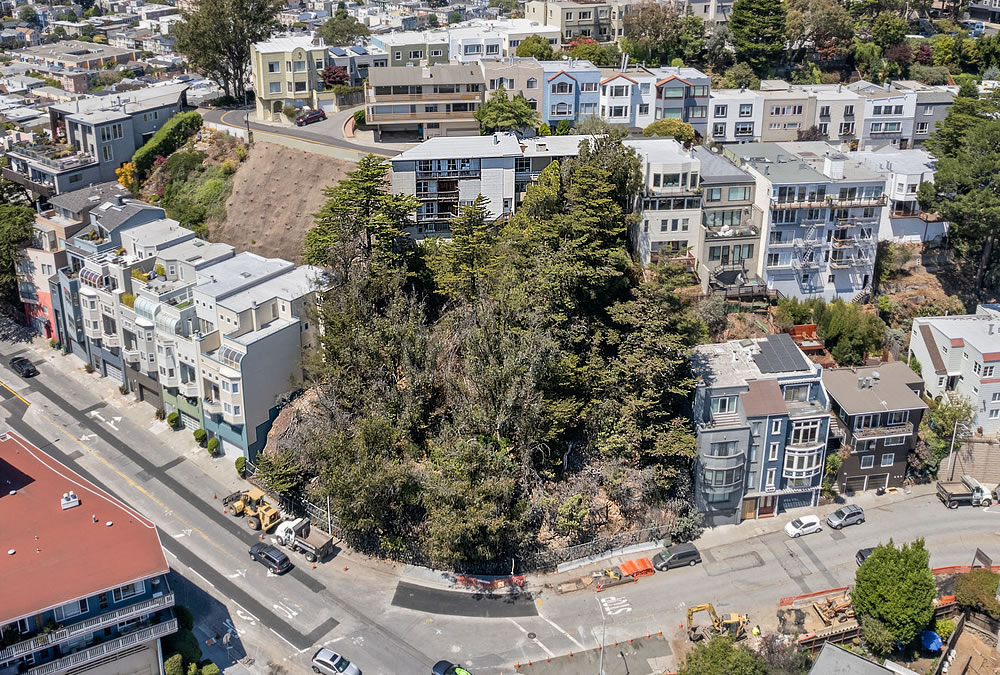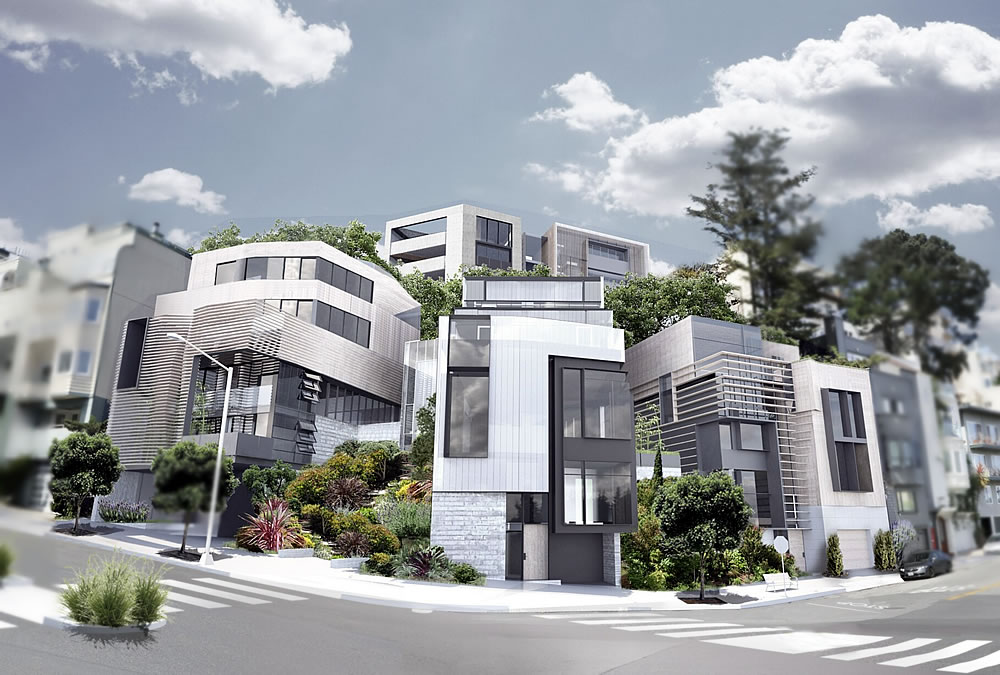The assembled site and plans for a proposed 10-unit development to rise on the northwest corner of 17th and Roosevelt, below the summit of San Francisco’s Mount Olympus on the southern border of Ashbury Heights, are now on the market with a $7.495 million price tag.
In the works since 2014, when Dawson & Clinton acquired the existing single-family home at 271 Upper Terrace, which sits atop the site, along with the undeveloped lot at 4500 17th Street and the existing duplex at 301-303 Upper Terrace for a little over $4 million combined, the development as proposed, which was dubbed the Mount Olympus project, would yield five modern duplexes, with the individual units ranging in size from 1,555 to 4,043 square feet and averaging 2,897 square feet apiece.
As we reported back at the end of 2018, a Preliminary Mitigated Negative Declaration for the development, which obviates the need for a detailed environmental impact report, has been signed and issued for the project which is now “in the final stages of approval” and being positioned as “ready for a savvy developer…who is ready to make this landmark opportunity a reality.”
If the plans for the proposed Mount Olympus development are approved and the ground is broken, the project team had been estimating that it would take around 37 months to complete, including the required excavation of the existing hillside and removal of about 13,640 cubic yards of soil, as we outlined a few years ago. We’ll keep you posted and plugged-in.


Three YEARS of construction (very optimistic) for just 10 units of housing? There are a lot of dumb projects in this town, but this might be the worst. Maybe tied with the Telegraph Hill one that ALSO will never be built.
This would essentially remove a(n admittedly small) forest. I don’t think there’s much doubt about the winner of the “dumbest” title.
A standard dump truck carries 10-16 yards of material; actual capacity will depend on weight rather than volume. Capacity might be 10 yards for stone, or 14-15 for topsoil. Removing the 13,640 yards of material would take 975 dump truck trips at 14 yard capacity, 1364 trips if 10 yard capacity – all from the busy 17th St and Roosevelt/Clayton intersection, the main intersection between UCSF Parnassus/ Cole Valley/ Ashbury Heights and Castro/ Market/ points east. Good luck with that; I’d hate to be a neighbor, or just anyone trying to navigate the area.
If it takes 3 months, it would be about 10-12 trucks per day, or one truck per hour.
One truck per hour you say? That’s 8 per day, or 6 months of 21 weekdays a month if 1000 trips, or 8+ months if 1364 trips/10 cubic yards a trip. Thanks, but I still wouldn’t want to deal with the associated headaches and traffic as a neighbor (or costs to cover/ recover as the developer. …Not to mention none of this dirt and rock is just sitting there waiting to be hauled off, but is part of the steeply pitched current terrain, shoehorned in by neighbors above and on either side, with the only flat staging area Roosevelt Way at 17th).
That’s right. One truck per hour.
If there is one vehicle every ten seconds normally, that would be 360 vehicles per hour. This moves the needle from 360 to 361. No one would notice. (And in fact, a busy street has many more vehicles than one every ten seconds.)
Dump trucks are noisier and more noticeable than an average vehicle. The bigger issue is probably the dust and noise associated with 40,000 pounds of earth being excavated and dumped into a dump truck every hour over the course of 6-8 months and traffic having to be stopped every time a dump truck enters or leaves the site.
One truck per hour.
Of course, I am well aware that there is always a reason to block housing. Always! But this is a really dumb one.
Oh, yes, the ever-present sarcastic “there is always a reason to block housing.” What this rhetoric doesn’t admit is that not every housing project is equally necessary. This is an unnecessary project, assuming it actually gets built, which is an assumption which very well may turn out to be false.
If the “site and plans for a proposed 10-unit development” sells for the asking price of $7.495 million, the resulting units will be completely unnecessary luxury housing (due to the number of units), targeted mostly at people who do not currently live in San Francisco. S.F. has plenty of housing in that price range already, and that will be the case for the foreseeable future. What S.F. needs is housing the people already living here and working here can afford to buy.
Sometimes I make a mistake. Sometimes I still think in terms of what is best for the city (building more housing) and forget what is in my personal best interest as a landlord (building no housing).
So I take it back! In the interests of my children, who will inherit my buildings someday and who will be able to obtain a higher rent if there is a limited supply of housing, I agree 100% that this should not go forward. No more housing!
I’m not joking. I’m now voting against all new housing and against any elected official who wants to build more housing. This is about my kids, and the more expensive housing is in San Francisco, the better their lives will be.
If “the resulting units will be completely unnecessary luxury housing” solely because of the price they will fetch, then just about everyone in San Francisco is living in completely unnecessary luxury housing. Which seems weird.
Perhaps you missed that I said nothing about wanting the project blocked or even that I was against it; my comments were about the neighborhood and traffic impacts and associated costs for the developer of building on such a site. Or perhaps your reading comprehension skills are as refined as your math skills (where 1 truck per hour over an 8 hour work day apparently equals 12 trucks, and there are 31 workdays in a month, not 21 or 22). Or perhaps reality and facts don’t matter, and you are simply dishonest or disingenuous, selling the idea that a single passing car per hour has the same neighborhood impact as a multiple months long hour after hour lineup of dump trucks getting loaded with rock and dirt, excavated from the steep site. In any event, your scorn is misdirected…as if a guy wondering aloud on some website about how many truckloads of rock and dirt a certain cubic yards might be is the thing that will derail an otherwise (apparently) perfect project.
Who knows exactly why the developer would push forward this project for 8 years, with over $4M invested, only to try to pitch it off to a “savvy developer” (aren’t THEY a savvy developer”?) just when it is “in the final stages of approval”, and just as the project is seemingly approaching what the developer is supposed to be best at – they call themselves “the best in Design Build Construction in San Francisco” saying, “Simply put, we are San Francisco’s premier General Contractor”. Sounds a bit hyperbolic, but If this team is as fabulous as they say they are, perhaps the project indeed doesn’t pencil out as they had hoped, and bringing the pieces of such a project together is indeed a daunting process, dumptrucks and all.
Speaking of reading comprehension, nowhere did I saw that “1 truck per hour over an 8 hour work day apparently equals 12 trucks”. What I said was “about 10-12 trucks per day, or one truck per hour”.
Some construction sites do not work 8 hour days. Also, some construction sites work weekends.
Oddly, in large projects I have been involved with in San Francisco, I do not recall the removal side being the issue, rather the adding back. Maybe removal just was more gradual.
For a large healthcare project we had to excavate 275 feet by 125 feet by 90 foot depth. That excavation had no issues. But the building back involved a mat slab foundation that was 6 feet deep that had to be created in a single continuous concrete pour. This was 7700 cubic yards of concrete delivered by concrete mix trucks at 13 cubic yards per mixer. To deliver this to the site on Geary Blvd. the the traffic plan issued to the state started at the Carquinez Bridge and one mile of a west bound lane of Geary had to be shut down for the line up of mix trucks waiting to dump their loads.
I think this is on a somewhat smaller scale… but nonetheless your anecdote is a good reminder to the “it’s my property I should be able to do what I want with it” crowd: it may well be your property, but it’s our roads you use to access it.
They aren’t all unaffordable, at least one is BMR right?
On the odd chance you’re not being facetious, that’s incorrect. As the project technically represents 8 new units of housing, structured as 4 new duplexes, along with a remodeled existing duplex, the project is exempt from having to provide or fund any units of inclusionary housing.
I wasn’t. I didn’t read into it, just saw that it is 10 units. Didn’t know they were remodeling 2.
Regardless, I just think it’s sad to see open space – even of this decrepit nature – being filled in. This rock face is a reminder of San Francisco’s natural topography and geology – after these homes are built it will be just another corner.
It’s not decrepit…it’s just not being staged properly
UPDATE: Price for Mount Olympus Site and Plans Slashed